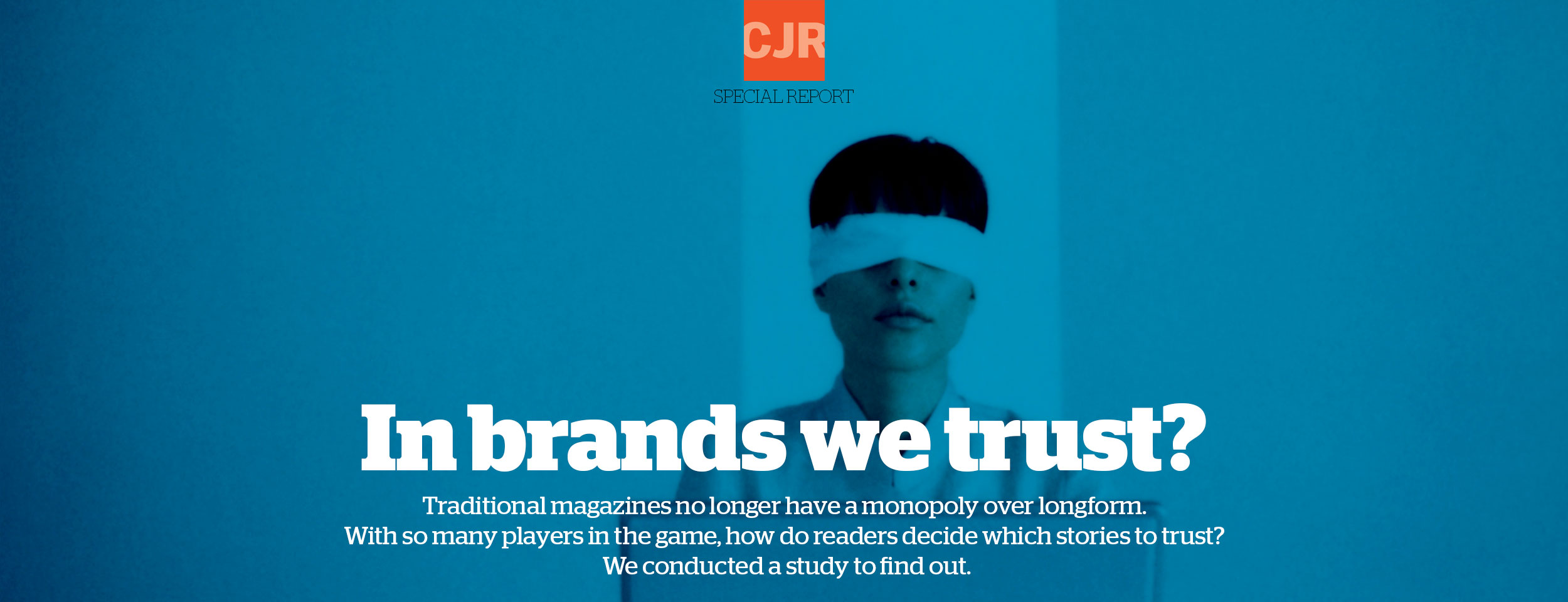Print anachronisms had DJ Khaled ranting recently. The record producer is one of the most-followed people on Snapchat, in part for his superhuman good cheer. But in an interview last fall with SiriusXM’s Sway in the Morning, Khaled was fuming about magazines being so out of touch as to leave him off their covers. “Some of these people that run magazines,” he huffed, “they’re dinosaurs.”
Then Khaled began to shake his head. “The thing is that your magazine is not as powerful anymore because this [is] the magazine,” he said, holding up his iPhone.
His statement has serious implications: Now that publications share a digital medium, is the power of magazine brands diminished? After all, how often these days do people remember reading something online but can’t recall the publication, if they ever took note of it in the first place? Today, social media account for nearly half of referrals to mainstream news organizations. More than 60 percent of social media users get news from those platforms, according to a 2016 survey by the Pew Research Center, with Facebook, the largest social platform, dramatically expanding its news focus in recent years.
Trust is among the most sacred qualities of a news brand. But in this atomized environment, media trust has taken a hit. Just 12 percent of people who consume news on Facebook say they trust what they find there, according to a recent study by the Associated Press and the American Press Institute. Across all social networks, respondents said they trust news found there “only somewhat.” “I think what they’re saying is, on Facebook, I’m not in a safe zone,” Tom Rosenstiel, API’s executive director, tells CJR. “I’ve got to be my own sheriff here.”

Paolo Pellegrin (Magnum Photos)
In less confusing times, reliable news brands served as guideposts—and to some degree, they still do. The American Marketing Association defines a brand as any feature that distinguishes one seller’s product from another’s. That’s not limited to qualities of the product, but also includes anything that contributes to its public perception. Consumers of journalism aren’t expected to accept a news article on its face but, rather, in the context of the outlet’s reputation. As the late New York Times publisher Arthur O. Sulzberger once said, “You’re not buying news when you buy The New York Times. You’re buying judgment.”
An experiment initiated by the George T. Delacorte Center and carried out by CJR’s three Delacorte fellows sought to learn how much weight readers give to a publication’s brand when evaluating a story’s credibility. The term “magazine” today is less descriptive of a particular medium than of an intimate and immersive relationship between a publication and its audience. When people read individual articles online without first encountering a print cover or Web homepage—or making a purchase—it’s worth exploring to what extent that sort of relationship survives.
When readers spent longer on a story, brands mattered less.
With the help of psychologist and cognitive neuroscientist Jenna Reinen, a postdoctoral scholar at Yale, we tested 267 people to see whether and how their trust in a deeply reported story depended on the magazine in which it appeared—or in which they thought it had appeared.
Each test subject read a digital version of the same story. For some readers, the story seemed to have run on The New Yorker website; for others, it appeared to have run in BuzzFeed. (As all subjects eventually learned, the article was originally published in Mother Jones.) We wondered if readers would have more faith in one version over the other. Would they even heed the brands? The results of our experiment will be published later this month.
The diversity of outlets now available on cable TV, radio, and the internet has stoked fears about consumers’ tendencies to seek out self-affirming perspectives on the news. But while liberals, for instance, might prefer news told from a liberal point of view, are they also inclined to have more confidence in the credibility of reporting at a liberal outlet versus a conservative one? In a separate but related study, we examined how readers interpreted a politically charged story depending on the publication’s stated ideological bent. Those findings will also be published later this month.
The potency of brands online is of enormous interest to many, and has been a topic of considerable scholarship. For journalistic outlets, we consider trust among the most important aspects of brand influence. We reviewed some of the research on branding and trust, which can be found here. In short, brand trust is belief in a product to deliver as promised. As a 2008 paper on “Trust in digital information” notes, trust only exists in the presence of vulnerability and uncertainty, both of which are fundamental to news consumption and accentuated by the dynamics of new media.
In this literature review, we evaluate what prior research suggests about the future of magazine brands online and how their stories will be consumed, especially when encountered by referral, such as via email, aggregator, or social media. We also consider that research as it relates to The New Yorker and BuzzFeed, prominent media brands with markedly different reputations. We will unpack the nature of trust—where it originates, how it’s nurtured, and why it matters. And we’ll survey some of the sprawling research and commentary on how news media contribute to political polarization and vice versa, particularly through outlets that carry a party or ideological banner.
When The Hollywood Reporter recently asked New Yorker editor David Remnick about his success extending his magazine’s “brand,” he replied, “I resist that word.” Indeed, many journalism veterans find the pervasion of business lingo soul-sucking. Yet consider another term from economics that’s often used to describe digital publishing: commoditization, when products in an industry become interchangeable, when brands dissipate, when readers don’t care where a story was published. That seems a trend worth resisting.
What’s odd about Remnick’s contempt for brand-oriented thinking is that magazines are perhaps the most emphatically branded form of news media. Even The New Yorker’s baroque style rules, such as including a diaeresis with words like coördinate and reëstablish, are ways of signaling tradition and sophistication. “Magazines are brands,” Callie Jean Blackwell flatly asserts in her master’s thesis at the University of Mississippi. “A brand is a promise and an expectation,” which clarifies how a news brand is both what a company says of itself and what consumers think of it. (For many years, the Chicago Tribune called itself “The World’s Greatest Newspaper.” The totality of its brand, however, was of course more complicated.)
Brands are essential to journalism in part because evidence suggests that consumers are inept judges of quality. In 2013, researchers Juliane Urban and Wolfgang Schweiger identified six normative criteria of news quality: diversity (of sources, for example); relevance (as in, timeliness); ethics (regarding treatment of story subjects); impartiality; comprehensibility; and accuracy. Six separate experiments were conducted to assess how readers discerned each of those variables. In every case, a news article was manipulated to develop high- and low-quality versions, which were presented as if published in a respected German newspaper or a sensationalist German tabloid. The researchers found that readers struggled to evaluate comprehensibility, ethics, and objectivity. When readers spent longer on a story, brands mattered less. When it was difficult for readers to identify quality differences, pre-existing opinions of the brands became more influential to their assessments. The researchers were unsurprised. Their review of preceding scholarship had suggested that “most media users have a limited understanding of news quality.”
News consumers are investing their time, if not their money, and they reward an efficient experience with more of their attention.
Perhaps the research closest in methodology to ours was published in 1994 by Journalism Quarterly. In that study, college students were given a short, fictitious article that had been made to look as if it had appeared in one of three newspapers of varying repute: The New York Times, a sensationalist tabloid called the Star, and a fictional regional newspaper far from the campus where the study occurred. Like us, the researchers reproduced those publications’ nameplates, typefaces, and surrounding advertisements. Six fictitious stories were created for the study; they were designated “easy to believe,” “hard to believe,” or “ambiguous,” with the goal of testing whether readers would be more strongly influenced by the content or the publication when determining if an article was real. The researchers found that judgments of believability were based entirely on the substance of the story, “with source reputation making no difference.” However, the actual judgment calls required of news consumers are usually more subtle than spotting fake stories. Our hypothesis is that when unreliability is not overt, brands are more likely to influence readers’ faith in accuracy, as was suggested by Urban and Schweiger’s study.

Erich Hartmann (Magnum Photos)
One of the authors of that 1994 paper, Erica Weintraub Austin, now vice provost at Washington State University, told CJR that follow-up research revealed a generational divide: Younger test subjects seemed more likely to base their decision about whether a story was fictitious on content, while older people seemed more influenced by the source’s reputation. The internet was in its infancy then; now, Austin suspects that the generational gap has only widened, and that a general disregard for the publication when gauging news credibility is more pronounced.
In marketing, “response expectancies” describe our tendency to experience things as anticipated. Advertising claims offer direct expectation cues, as opposed to “global beliefs,” like the assumption that lower price equals lesser quality, note Baba Shiv, Ziv Carmon, and Dan Ariely in a 2005 commentary on their work. In this publication, the researchers review experiments in which college students were given SoBe energy drinks, and then asked to complete a word puzzle. The students who thought their beverage was discounted performed worse. This insight suggests that news websites with a paywall, like newyorker.com, may also promote increased quality expectations. Another study at Columbia University and MIT used tainted beer to understand response expectancies. Three groups of test subjects sampled a beer to which a few drops of balsamic vinegar had been added. One group thought it was ordinary beer, one learned of the vinegar before drinking, and one learned soon after. Those who were told beforehand that vinegar had been added were significantly more likely to find the drink distasteful. This suggests that learning about a product beforehand changes the experience itself, rather than simply swaying our interpretation of the experience in retrospect.
Aesthetic elements such as name, logo, and design have also been shown to be essential to digital branding. A 2012 article in the International Journal of Electronic Business Management identified how website interactivity, security, and ease-of-use tend to enhance brand loyalty. News consumers are investing their time, if not their money, and they reward an efficient experience with more of their attention.
Design is also key to generating reader trust. In 2003, researchers at Stanford University asked more than 2,600 people to analyze the credibility of two websites. They found that visual design elements were given the most consideration, with little attention paid to content or source. “People typically process web information in superficial ways,” they concluded, adding that “using peripheral cues is the rule of web use, not the exception.”
Brands “represent a substitute for information—a way for consumers to simplify the time-consuming process of search and comparison,” explains a 2007 paper on “i-Branding.” Yet information is abundant on social media, where sharing a story usually counts as a tacit endorsement, and “search and comparison” is not such a great imposition. Under such conditions, are brands rendered an afterthought?
It’s probably challenging to maintain brand consistency when you’re “this insane morphing rocket ship,” as a creative director at BuzzFeed recently described the digital native. The company aspires to be a media empire, but it has never been entirely clear where news fits within that vision.
Founded in 2006 by Jonah Peretti, a co-founder of the Huffington Post*, BuzzFeed’s enormous success has come from embracing “distributed publishing,” using platforms like Facebook and Twitter to go straight to its audience. BuzzFeed proudly reports that 75 percent of its 200 million unique monthly visitors come from social platforms. As media critic Peter Kafka of Recode notes, “This is antithetical to conventional Web publishing wisdom, which says that you want to keep as many eyeballs as possible looking at your stuff on your properties so you can maximize the ad dollars that stuff generates.” Yet with consistent profitability, even in the face of sobering revenue growth last year, BuzzFeed is rewriting convention. News sites have realized the diminishing significance of their homepages; BuzzFeed’s is virtually irrelevant.
In short, brand trust is belief in a product to deliver as promised.
BuzzFeed News is its own vertical, night-and-day different from BuzzFeed’s notoriously fluffy listicles but not walled off from them. The company has aggressively recruited a top-tier investigative team led by Mark Schoofs, the Pulitzer Prize-winning former ProPublica senior editor. An analysis of BuzzFeed’s journalism in The Baffler last year concludes that BuzzFeed covets recognition for having outgrown “listicles and other viral nonsense. And in many respects, BuzzFeed has achieved that [recognition].”
Despite admirable work by its news division, BuzzFeed is still plagued by a tenuous relationship with advertisers. Its revenue comes largely from branded content, and a vague wall between business and editorial continues to trouble BuzzFeed’s image. That concern relates to BuzzFeed’s enthusiasm for native advertising and its checkered history of allowing advertising interests to influence editorial decisions. Since BuzzFeed’s notoriety originated from serving the junk food of internet journalism, we were eager to see whether test subjects would take an investigative magazine story by BuzzFeed as seriously as one that seemed to have been published in one of its legacy counterparts. In that regard, responses to the BuzzFeed version of our story should be generalizable to digital natives that offer, but don’t necessarily prioritize, rigorous journalism.

Paolo Pellegrin (Magnum Photos)
The New Yorker, meanwhile, represents a gold standard of in-depth journalism. It is known for its thorough reporting, literary excellence, and fact-checking rigor. Whereas some legacy brands read like an entirely different publication online, original content on newyorker.com is reminiscent of the weekly print product.
Because The New Yorker brand hinges on high-quality journalism, the magazine has been shielded from “many of the money-generating schemes that other outlets have, whether enthusiastically or reluctantly, embraced,” The New York Observer noted earlier this year. The New Yorker recently expanded to video and podcasting, a bold bet on the durability of its brand. It also adjusted its social media strategy and bolstered its copy desk in an attempt to broaden its digital reach without compromising quality.
There’s an aura emanating from stories in The New Yorker, whether in print or online. Maybe that’s due to the elegant page design, or, more likely, to the sterling reputation of the 91-year-old brand. We wondered how much the magazine’s cachet raises our estimation of a piece, apart from the copy’s merits.
Allegations of political bias in news coverage usually target outlets that proclaim impartiality. But for magazines with proud ideological identities—The Nation and National Review, for example—concerns about trustworthiness take on a different character. Such publications can still have rigorous standards for accuracy and offer news features claiming no partisan angle. Whether readers perceive a slant or question some facts might depend on their own political dispositions.
To test that hypothesis, we asked 161 subjects about their political leanings, then asked about half of them to read a longform news story in a fictional magazine of conservative orientation; the other half read a story from a fake, supposedly liberal outlet. To identify the political leanings of those fictional publications—the liberal American Progressive and the conservative Patriot—we provided a paragraph explaining their supposed bent and background. All subjects read the same article about a foiled plot to kill police in Las Vegas, which, they eventually learned, was originally published in The California Sunday Magazine.
The politicization of news outlets correlates with the size of their market. Local newspapers generally seek to appeal to a broad audience because they have limited competition. The same is true of network news programs. When competition increases, outlets tend to target an ideological niche, particularly with a greater emphasis on commentary. The internet allows limitless competition, thus the incentive to cater to a specific audience is at its peak. But only a small minority of Americans get most of their news from sources that are politically one-sided, according to “Media and Political Polarization,” a paper by Princeton professor Markus Prior. Those people tend to be the hyper-partisan, and also tend to distrust mainstream media. A 1988 study by Albert Gunther, then a doctoral candidate at Stanford, asked subjects to rate the intensity of their beliefs around three contentious topics—welfare, abortion, and Latin America policy—and how much they trusted television and newspaper coverage of those issues. Gunther found that people of low and high ideological intensity, whether liberal or conservative, were less trusting of media in general than those in the middle.
We wondered how much The New Yorker’s cachet raises our estimation of a piece, apart from the copy’s merits.
As part of an extensive examination of American political polarization in 2014 by the Pew Research Center, 2,901 people participated in a survey of media habits. Respondents were asked whether they trusted or distrusted 36 news outlets, ranging from The Economist to The Rush Limbaugh Show. Pew found a dramatic divide: Liberals, who consumed a much wider variety of news sources in general, said they trusted more than distrusted 28 of the outlets, while conservatives said they distrusted more than trusted 24 of the outlets. Perhaps most significantly, “[a]ll six of the sources overwhelmingly distrusted by consistent liberals are overwhelmingly trusted by consistent conservatives.”
(With our other study on branding in mind, it’s noteworthy that fewer than 40 percent of respondents from this 2014 survey said they’d heard of BuzzFeed. Both conservatives and liberals said they distrusted more than trusted BuzzFeed. And The New Yorker had a more consistently liberal audience than any outlet included in the survey.)
“The hostile media phenomenon,” as three Stanford professors dubbed it in 1985, describes news consumers’ inclination to find coverage biased against their beliefs. Four years earlier, those researchers had conducted a telephone survey asking 160 people to rate coverage of the 1980 presidential election between Jimmy Carter and Ronald Reagan. Sixty-six percent of respondents said coverage had been fair, but among Carter supporters who thought coverage had been skewed, 83 percent said it had favored Reagan, and among Reagan supports observing bias, 96 percent said media had favored Carter. In a subsequent 1985 study, pro-Israeli and pro-Arab test subjects viewed identical network news coverage of the 1982 Beirut massacre, and both groups deemed it skewed against their perspective.
The researchers concluded that two closely related perceptions created the hostile media phenomenon. First, test subjects saw the issue as black or white, and thus rejected the notion of a grayish reality. Second, because they saw it as black or white, journalists’ attempt at an account that balanced both sides suggested hostile bias. But maybe most important, the researchers observed, was “the tendency for both groups to assert that neutral viewers will turn against their side when they view the media coverage.”
Analyzing national survey data from 1948 to 2004, University of Kansas professor Tien-Tsung Lee found that people who trust the government are more likely to trust the media, as are liberals, whereas conservatives are less likely. But what about when reading news in publications unabashedly of the opposite affiliation? It would be unremarkable to learn that conservatives and liberals are less compelled by, or interested in, liberal and conservative magazines, respectively. But as a matter of basic trust in the integrity of reporting, a divide based on political orientation could yield useful insights.
Brands, whether institutional or personal, still have power. Sixty-six percent of respondents to The Media Insight Project survey from earlier this year said their most important basis for trust on Facebook is the news organization that produced the content, while 48 percent said they’re most concerned with the reputation of the person who shared the material; most respondents claimed not to base trust on how many “likes” a piece received.
But that finding comes with a corollary: The more people rely on social media for news, the less likely they are to trust those platforms. “Internet users are not willing to spend a lot of time and effort on verifying the credibility of online information,” a 2012 study in the Journal of Information Science explains, “which means that various rules-of-thumb are applied to speed up the process.”
That study assessed responses to a polarizing and ambiguously sourced digital information hub, Wikipedia, and found that readers demonstrated a layered basis of trust, where each layer builds on the next. At the base is trust in the information itself, followed by trust in the source, the medium, and finally, one’s general propensity to trust. Accordingly, our study’s post-experiment questionnaires seek to identify whether and in what ways a subject is predisposed to be trusting.
Trust implies risk. With news, that risk is in wasting your time, squandering your money, or proliferating faulty information via social media. Most fundamentally, though, it’s in being misinformed. Since the era of yellow journalism, the most prestigious news brands have cherished their reputation for trustworthiness. Magazines, in particular, breed a loyal readership. If that relationship proves to be antiquated online, so too is our understanding of a magazine.
*An earlier version of this story mistakenly identified Peretti as a co-founder of Twitter. We regret the error.
Danny Funt, Chava Gourarie, and Jack Murtha are CJR Delacorte Fellows.

